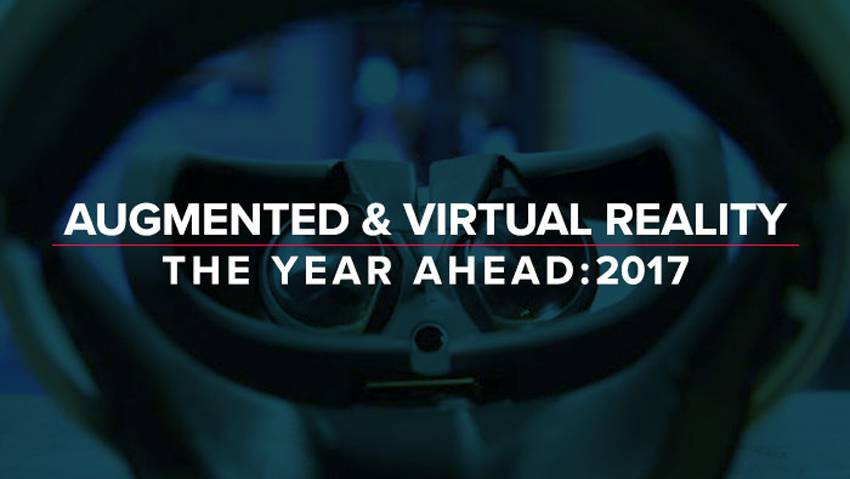
2017 is yesterday’s news! Check out our top Virtual Reality and Augmented Reality technology trends for 2019 and see what’s in store for the year ahead. For more information on how retailers are using mixed commerce solutions, check out our Mixed Commerce Glossary, which defines the terminology being used to businesses to describe the changes currently sweeping retail.
What are the top Virtual Reality and Augmented Reality technology trends for 2017?
2016 was a breakthrough year for Virtual Reality and Augmented Reality. On the VR side, big-name hardware like the Oculus Rift, HTC Vive and Playstation VR all hit the marketplace, bringing with them a flood of content and clever implementations that had early adopters evangelizing about the exciting new technology. On the AR side, the worldwide hit Pokémon Go brought Augmented Reality into the mainstream, setting App Store records in the process. As we enter 2017, the industry is looking to capitalize on this momentum.
So what’s in store for Virtual Reality and Augmented Reality in 2017? We asked Marxent’s talented team of computer vision experts, 3D artists and engineers to help us suss out what the year ahead will hold. Here are their predictions for the top Virtual Reality and Augmented Reality technology trends for 2017.
1. Cut the cord! Wireless Virtual Reality tech to make huge splash in 2017
Our plugged-in world is about to meet the dustbin of history. You could see the wireless trend emerging in 2016 — the adoption of a new Bluetooth standard, Apple’s new W1 wireless audio chip and earbuds — and the next year will see products across categories ditch the wires in favor of more magical solutions.
In Virtual Reality, this means wireless VR Head Mounted Displays (HMDs). The current generation of hardware has the user connected to a powerful PC via annoying cables. We are excited to be freed from cables in 2017. To the companies that are working on wireless headsets, such as HTC (which has already partnered with TPCAST to create an add-on that makes the current Vive wireless) and will be the first to market with a fully wireless HMD, we say THANK YOU! Of course, the folks at Oculus, Google, Sony, Apple or Microsoft. In any case, we can’t wait for wireless. It is without question the best Virtual Reality technology trend that will come to VR in 2017.
2. Internet of Things (IOT) will make wireless VR more beautiful – and more dangerous
Beyond wireless VR, Silicon Valley and major manufacturers are constantly looking for new ways to innovate cords and cables out of the equation. There’s already an enormous Internet of Things (IoT) that allows millions of connected appliances to communicate wirelessly (and sometimes get hijacked by hackers), and the next year will see programmers find new and exciting ways to leverage all that IOT connectivity.
We’d be remiss if we didn’t mention what could be the most important development in wireless for 2017. Word is that Apple is partnering with a company called Energous on a breakthrough wireless charging solution that will allow the next iteration of the iPhone to charge from across a room. The tech exists, and if Apple really does roll out what Energous has developed, it would instantly create a new product ecosystem around wireless charging.
3. AR becomes the killer app for smartphones
Speaking of Apple, there’s been a consistent, low rumble of hype saying the next iPhone will include hardware-level Augmented Reality. Tim Cook has gone on the record to sing the praises of AR, and Google’s Tango platform and the Lenovo Phab 2 smartphone have already shown how such a system might work. So, is AR going to be the big feature that sells smartphones in 2017? To the few and the fabulous, but it is unlikely to make it’s debut in currently popular smartphone lines this year.
Yes, Apple will finally make an Augmented Reality SDK accessible to developers, which should open the doors to more powerful iOS AR apps in 2017. That said, additional hardware like a depth-sensing camera (RGB-D, for example) will be required to create smartphones that include true, hardware-based AR. This tech will likely be available to fanboys of the iPhone, Samsung’s Galaxy line, or the Google Pixel in 2018.
That leaves an opening for other manufacturers to use advanced AR features as a way to grab market share. As if on cue, Asus unveiled the ZenFone AR at this year’s CES. The ZenPhone comes loaded with Google’s Tango technology, and Asus CEO Jerry Shin touted the handset in the press, saying, “The ZenFone AR will come with advanced functionality and performance at a competitive price.” Though it’s highly doubtful the ZenFone will displace the iPhone at the top of the smartphone world any time soon, the AR functionality Asus is bringing to market is here to stay, and will be baked in to multiple handsets by year’s end.
4. You’ll shop in Virtual Reality
Virtual Reality is about to shake up retail, with the planet’s biggest merchants already making moves to take control of this emerging category. Global giant Alibaba, the world’s largest retailer, has launched a VR store called Buy+ that allows shoppers to wander a VR mall complete with big name stores like Macy’s, Target and Costco. Internet auction giant eBay teamed with Australian retailer Myer for what was touted as “the world’s first VR department store.” Meanwhile, retail colossus Amazon.com may not be far behind, as recent job postings hint at a future VR for Prime shoppers.
Beyond e-commerce, VR is also seeing steady adoption across a host of product categories. There’s already a VR car dealership, and VR for real estate has been gaining traction for a while. 2017 will see Ashley Furniture, the largest furniture manufacturer in the world, bring VR into its showrooms for the first time. Ikea is also embracing VR by allowing shoppers to design their dream kitchen — something home improvement giant Lowe’s started working on a few years ago using Marxent’s Virtual Realty Showroom. Expect to see VR pop up in many more retail spaces in 2017, as businesses experiment with the best ways to utilize the technology.
5. Someone will try to live in VR for a week straight
The only question is whether it will be done in the name or art or science. No matter the reason, some brave psychonaut will don a VR headset and attempt to set a record for the most amount of time spent in a VR space without taking a break. If the above video features Derek Westerman enduring 25 hours in an HTC Vive is any indication, the person that eventually breaks the record is in for a dizzying but thrilling experience.
But don’t take our word for it …
There are plenty of writers and publications offering their vision for what the next 12 months hold for VR, AR and tech in general. Here are a few of our favorites:
- Digital Trends: Why 2017 Will Be Shaped by VR, AR, AI and Personalized Digital Assistants [Newsweek]
- 15 Virtual Reality Trends We’re Predicting for 2017 [Appreal]
- Three Big Tech Trends For 2017 [Forbes]
- VR/AR In 2017: Where Will Virtual/Augmented Reality Go In The Coming Year? [International Business Times]
- VR trends to look out for in 2017 [Slash Gear]










